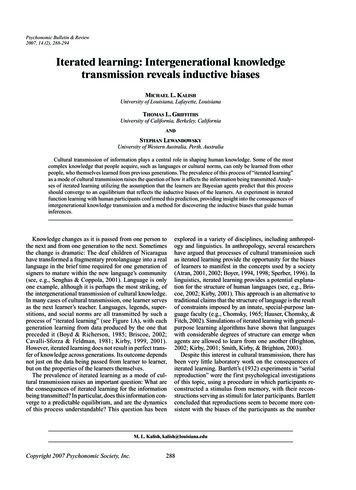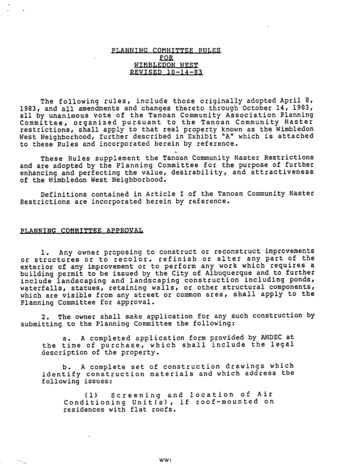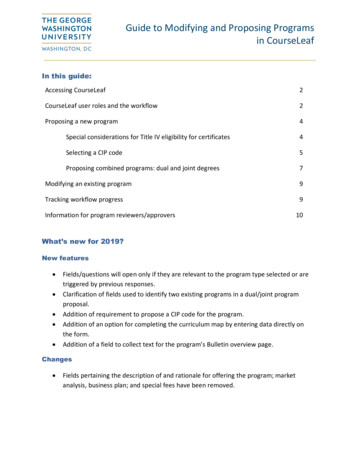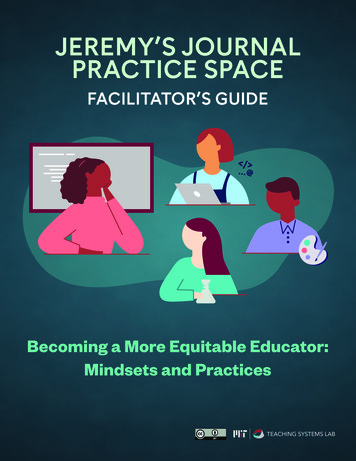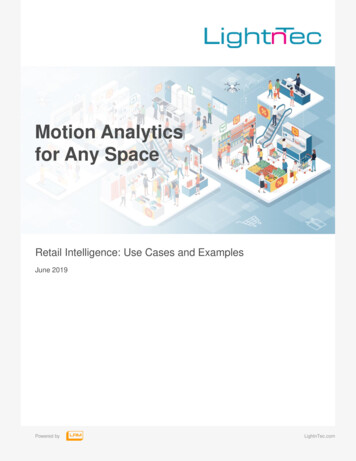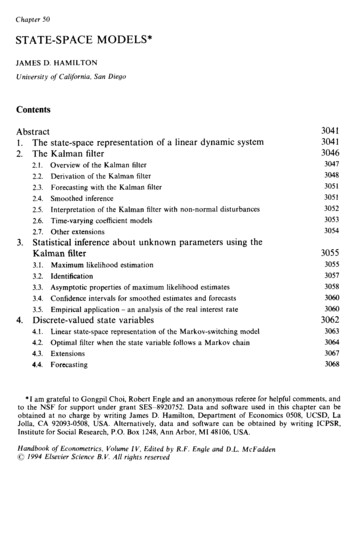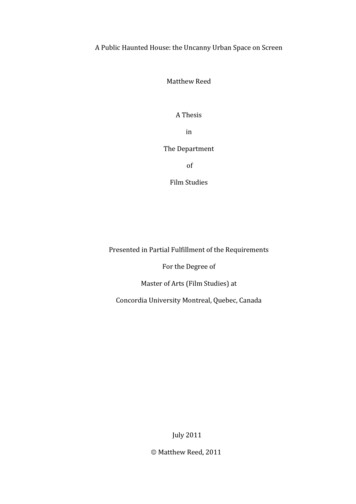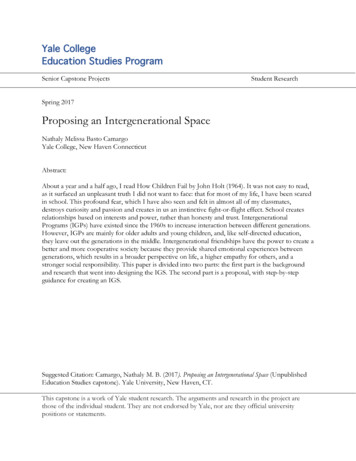
Transcription
Yale CollegeEducation Studies ProgramSenior Capstone ProjectsStudent ResearchSpring 2017Proposing an Intergenerational SpaceNathaly Melissa Basto CamargoYale College, New Haven ConnecticutAbstract:About a year and a half ago, I read How Children Fail by John Holt (1964). It was not easy to read,as it surfaced an unpleasant truth I did not want to face: that for most of my life, I have been scaredin school. This profound fear, which I have also seen and felt in almost all of my classmates,destroys curiosity and passion and creates in us an instinctive fight-or-flight effect. School createsrelationships based on interests and power, rather than honesty and trust. IntergenerationalPrograms (IGPs) have existed since the 1960s to increase interaction between different generations.However, IGPs are mainly for older adults and young children, and, like self-directed education,they leave out the generations in the middle. Intergenerational friendships have the power to create abetter and more cooperative society because they provide shared emotional experiences betweengenerations, which results in a broader perspective on life, a higher empathy for others, and astronger social responsibility. This paper is divided into two parts: the first part is the backgroundand research that went into designing the IGS. The second part is a proposal, with step-by-stepguidance for creating an IGS.Suggested Citation: Camargo, Nathaly M. B. (2017). Proposing an Intergenerational Space (UnpublishedEducation Studies capstone). Yale University, New Haven, CT.This capstone is a work of Yale student research. The arguments and research in the project arethose of the individual student. They are not endorsed by Yale, nor are they official universitypositions or statements.
Proposing an Intergenerational SpaceNathaly Melissa Basto CamargoEducation Studies ProgramSenior Capstone EssayYale UniversityNew Haven, CTMay 8, 2017
2
ForewordAbout a year and a half ago, I read How Children Fail by John Holt (1964). In short, itchanged my life. It was not easy to read, as it surfaced an unpleasant truth I did not want to face:that for most of my life, I have been scared in school. This profound fear, which I have also seenand felt in almost all of my classmates, destroys curiosity and passion and creates in us aninstinctive fight-or-flight effect. After reading Holt’s book, I saw that this fear, which starts earlyin school, is the foundation for the establishment of our passive and isolated society. Schoolgives us the habit of believing that knowledge is something to abstractly learn, rather thansomething to do. School also makes us believe that knowledge is divided according to subjectsand that people are somehow essentially divided according to age, rather than revealing theinterconnected nature of knowledge and the fluidity of human life stages. School createsrelationships based on interests and power, rather than honesty and trust. School mandates a fastpaced atmosphere of toxic stress, rather than a slow-paced one of balance and well-being.Consequently, children, adolescents, and young adults in school live incredibly lonely, confused,unhealthy, and unbalanced lives—though they mask it—all while passing through profoundpersonal transformations.At first I thought I was alone in these views, until, through a coincidental encounter,someone took me to an intriguing place in New Haven called Beacon Self-Directed Learning.Beacon was not a school, one of the directors affirmed; it was a social community forhomeschooled teenagers to learn how they wished. I fell in love with Beacon and startedvolunteering there. At Beacon, I was introduced to the large network of the unschooling and selfdirected community in the United States and the world. As it turned out, I was not alone. I talkedwith founders of other Self-Directed Learning Centers and visited a Sudbury school in3
Connecticut. I found that these environments helped maintain the curiosity, creativity, and wellbeing of children because of their intimacy, respect, and balance.However, I also realized that, as alternative as these models are, they are also agesegregated. For example, most Self-Directed Learning Centers are for teenagers and Sudburyschools are for children and teenagers. These centers would be strengthened if they opened to allages, I came to conclude as I volunteered and observed. Consequently, I developed the conceptof “intergenerational learning,” which goes beyond age-mixing. Intergenerational learning iswhere people from all generations learn together: children (aged 0-12), adolescents (aged 13-17),young adults (aged 18-39), middle age adults (aged 40-64), and older adults (aged 65 and over).I soon found out that, once again, I was not alone in my idea of intergenerational (IG)learning. To my surprise, Intergenerational Programs (IGPs) have existed since the 1960s toincrease interaction between different generations. However, IGPs are mainly for older adultsand young children, and, like self-directed education, they leave out the generations in themiddle. After I visited an IGP in Van Nuys, California, I also saw that IGPs are highly controlledand do not leave much time for unstructured interaction.It was at that point that I clearly saw the need for a particular kind of place—anIntegrational Space (IGS), an unstructured space in which we can relax, lead a balanced life, andmake meaningful friendships with people of all generations. These intergenerational friendshipshave the power to create a better and more cooperative society because they provide sharedemotional experiences between generations, which results in a broader perspective on life, ahigher empathy for others, and a stronger social responsibility.This is an academic paper that fulfills the senior requirement for the Yale UniversityEducation Studies Program. Simultaneously, it is also a proposal for the general public to be able4
to understand and implement in their communities. As such, this paper is divided into two parts:the first part is the background and research that went into designing the IGS. The second part isa proposal, with step-by-step guidance for creating an IGS.PART IA. Self-Directed EducationThe image and sensations most of us most likely experience when we hear the word“education” are of desks, whiteboards, teachers, grades, and homework. These images were firstpublically challenged in the United States by John Holt. In 1964, after years of teaching in theBoston public schools, Holt published the diaries from his teaching experience in his book HowChildren Fail (1964). From his experiences, Holt came to the conclusion that school createspervasive fear in children and that, in truth, school makes them stupid—or at least makes themact stupidly. Holt continued to write many more books about the negative impact of schools andabout the rights children should have in society, such as the rights to determine what they learn,the right to vote, and the right to work (Holt, 1972). Moreover, Holt became an advocate ofhomeschooling and began spreading the idea of homeschooling in local communities.Holt was highly influenced by Ivan Illich, who wrote Deschooling Society in 1970. In thisbook, Illich argued for the disestablishment of school, claiming that we have become a “schooledsociety,” (p. 67) and that the primary purpose of school is to shape “man’s vision of reality,” (p.47). Illich furthermore said, “school enslaves more profoundly and more systematically, sinceonly school is credited with the principal function of forming critical judgement, and,paradoxically, tries to do so by making learning about oneself, about others, and about naturedepend on a prepackaged process,” ( p. 47). In other words, Illich highlighted this paradox: thatin school, we all need to have the exact same critical thinking; in particular, our critical thinking5
should match the “critical” thinking of the teacher, otherwise, the school fails us. Illich’s solutionto these educational problems was that “each man define himself by learning and bycontributing to the learning of others,” (p. 71). This quote set the foundation for the large andgrowing movement of self-directed education, which will be described later in this section. Illichconcluded his book by describing the three purposes of an ideal education: “It (education) shouldprovide all who want to learn with access to available resources at any time in their lives;empower all who want to share what they know to find those who want to learn it from them;and, finally, furnish all who want to present an issue to the public with the opportunity to maketheir challenges know,” (p. 75). In summary, according to Illich, education should providemeaningful resources that enable teaching and learning relationships as well as free speech.A few years after writing How Children Fail, Holt coined the term “unschooling,” whichis similar to homeschooling but differs from homeschooling in that children do not have schoolat home (Gray, 2013; P. Farenga, Skype Interview, 2017, March 6). In 1977, Holt started themagazine Growing Without School to spread the idea of unschooling and to providehomeschooling and unschooling resources to the American population. At around this time Holtalso wrote: Instead of Education: Ways to Help People Do Things Better (1976), where heexplained the homeschooling and unschooling process for families who were seeking alternativeeducational options. In this book, Holt famously described his views of education:Education, with its supporting system of compulsory and competitive schooling, all itscarrots and sticks, its grades, diplomas, and credentials, now seems to me perhaps the mostauthoritarian and dangerous of all the social inventions of mankind. It is the deepestfoundation of the modern and worldwide slave state, in which most people feel themselvesto be nothing but producers, consumers, spectators, and “fans,” driven more and more, inall parts of their lives, by greed, envy, and fear. My concern is not to improve “education”but to do away with it, to end the ugly and antihuman business of people-shaping and letpeople shape themselves. (Holt, 1976, p. 4).6
Holt had a deep concern for the essential bribery and competition that schools created by virtueof their design, and he came to conclude that there was no solution to the educational systemother than to end it for good. He proposed a solution similar to that of Illich: instead ofgovernments imposing a massive-scale solution, groups of families and small communitiesshould come up with smaller-scale learning centers and schools that meet the needs of theirchildren. Moreover, parents should take their children out of school and help their childrenpursue their education in a more humane matter.About twenty years after Holt and Illich, John Taylor Gatto wrote another importantunschooling book: Dumbing Us Down, The Hidden Curriculum of Compulsory Schooling(1992). Gatto asserted that no matter how much we try, education and school can never be thesame. He said, “No amount of tinkering will make the school machine work to produce educatedpeople; education and schooling are, as we all have experienced, mutually exclusive terms,” (p.101). He argued that schools are artificial networks that appear to be communities, but are in factnot communities. Gatto said,By preempting fifty percent of the total time of their young, by locking young people upwith other young people exactly their own age, by ringing bells to start and stop work, byasking people to think about the same thing at the same time in the same way, by gradingpeople the way we grade vegetable network schools steal the vitality of communitiesand replace it with an ugly mechanism. No one survives these places with their humanityintact, not kids, not teachers, not administrators, and not parents. (Gatto, 1992, p. 56).Gatto was also influenced by Holt and Illich, and much of his work was similar to their works.The writings of Holt, Illich, and Gatto was one factor that increased the number of homeschooledchildren. According to Pat Farenga, who worked with Holt in the magazine Growing WithoutSchooling, there were about 25,000 homeschooled children in 1981 (P. Farenga, SkypeInterview, 2017, March 6). This population increased rapidly within the next five years. By1985, Farenga estimates that there were around 35,000 homeschooled children (P. Farenga,7
Skype Interview, 2017, March 6). In 1999, the first estimates of homeschooling families werereported, which stated that there were 850,000 homeschooled children in the United States (TheU.S. Department of Education, 2016). This number has grown exponentially. In 2012, there werean estimated 1.8 million homeschooled students in the United States (U.S. Department ofEducation, 2016)—almost 2 million. Farenga believes that the internet was one of the biggestfactors that contributed to this increase (P. Farenga, Skype Interview, 2017, March 6).Though the number of homeschoolers is known, the exact number of unschoolers isunknown, since there is no separate classification for them other than homeschoolers (Gatto,2013). However, people in homeschooling estimate that about ten percent of homeschoolers areunschoolers (Gatto, 2013). There are many unschoolers who attend democratic schools, learningco-ops, and self-directed education centers. The Alternatives to School (2017a) website providesa directory of schools or centers that are aligned with Self-Directed Education. In this directory,there are 47 democratic schools in the United States and Canada and there are 38 Learning Coops, Resource Centers, and Self-Directed Learning Centers in Canada, the United States, andPuerto Rico (Alternatives to School, 2017a), showing that these educational models are stillsmall and reaching only a few people.This year, in 2017, due to the increase of self-directed education centers and unschoolers,leaders in self-directed education came together to form the Alliance for Self-Directed Education(ASDE), which is a nonprofit that aims to inform people about the benefits and methods forallowing children and adolescents to direct their own education. According to the ASDE,compulsory education violates the human right of children and families “to direct their ownlives, learning, and paths to adulthood,” (ASDE, 2017a). Consequently, the ASDE hopes tocreate a community of people who self-direct their own education and who, together, can8
transform education and society and bring back the essential human right of self-directededucation.One of the most important accomplishments of the ASDE is that they developed a muchneeded alternative definition of education, which is: “Education is the sum of everything aperson learns that enables that person to live a satisfying and meaningful life. This includes thekinds of things that people everywhere more or less need to learn, such as how to walk upright,how to speak their native language, how to get along with others, how to regulate their emotions,how to make plans and follow through on them, and how to think critically and make gooddecisions” (ASDE, 2017b). There are two crucial points to glean from this definition. The first isthat education is for living a satisfying and meaningful life, so whatever a person learns orexperiences that does not lead towards a meaningful life, is not education. The second point isthat education is based on people’s needs. We all share basic needs, but we also all have differentneeds that come from our different experiences. Thus, we all need a different type of education.From this definition of education grows the concept of self-directed education, which is:“the self-chosen activities and life experiences of the person,” (Gray et al., 2016). The idea ofself-education education is that, if children need to learn something, we can trust that they willfind the resources and help to learn it; we do not need to force, standardize, or grade thislearning. The ASDE gives six conditions for self-directed education to work: 1) socialexpectations that education is children’s responsibility 2) unlimited time to play, explore, andpursue one’s own interests 3) opportunity to play with the tools of the culture 4) access to avariety of caring adults who are helpers, not judges 5) free age mixing among children andadolescents 6) immersion in a stable, respectful community (ASDE, 2017c). Gatto (1992)reflects this idea by saying, “Whatever an education is, it should make you a unique individual,9
not a conformist; it should furnish you with an original spirit with which to tackle the bigchallenges; it should allow you to find values which will be your road map through life; it shouldmake you spiritually rich, a person who loves whatever you are doing, wherever you are,whomever you are with; it should teach you what is important, how to live and how to die,” (p.75). All of these points are crucial and necessary for our educational and for our schools.One of the six components listed above is age mixing. Daniel Greenberg, the founder ofthe Sudbury Valley School, asserts that age mixing is the secret weapon that has allowed theSudbury Valley School to succeed (Greenberg, 1992). Gatto (2013) claims that free age mixingallows young children to “engage in and learn from activities that would be too difficult for themto do alone; learn from and be inspired by older ones through watching and listening to them;and receive more care and emotional support that they otherwise would .allows older childrento practice and develop their nurturing and leadership skills and capacities; learn throughteaching; and engage in more playful, creative, and artistic activities than they otherwise would,”(p. 203). When we divide children by ages and grades in schools, they do not have these crucialopportunities.Often times, unschooling parents have the view that “school is prison,” (Gray, 2013, p.67) and thus seek to give their children the most amount of freedom possible. Or, parents whohave their children in school come to realize that school has become a prison for their children;thus, they start to unschool them. There is no set procedure to unschooling and its mechanismscan vary widely. As Gray (2013) describes, “unschooling parents do not send their children toschool, and at home they do not do the kinds of things that are done at school. They do notestablish a curriculum, do not require particular assignments for the purpose of education, and ofnot test their children to measure progress. Instead, they allow their kids freedom to pursue their10
own interests and to learn, in their own ways, what they need to know to follow those interests,”(p. 227-228). From a study on 232 families, more than a third decided to unschool their childrenbecause of the harmful effects on their children, such as depression, anxiety, and loss of interestin learning (Grey, 2012). All families claimed that unschooling had positive effects on theirchildren’s happiness, assertiveness, or self-confidence, curiosity, learning, and family closeness.Research shows that children who spend more time in less-structured activities havebetter self-directed control and have better self-directed executive functions than children whospend more time in structured activities (Barker, 2014). Play is an important form of self-directededucation. As Gray (2013) describes, play is self-chosen and self-directed. Research shows thatlearning, problem solving, and creativity are worsened by interventions that interfere withplayfulness and improved by interventions that promote playfulness (Gray, 2013; Smith, 2005).One study (Gray & Riley, 2015) shows that unschoolers who had not gone through K-12education were the most likely in the group to pursue a bachelor’s degree or higher. Even withno formal preparation for college, they got “As” and honors. Most importantly, their experiencesas unschoolers “prepared them well for
Boston public schools, Holt published the diaries from his teaching experience in his book How Children Fail (1964). From his experiences, Holt came to the conclusion that school creates pervasive fear in children and that, in truth, school
